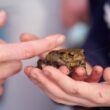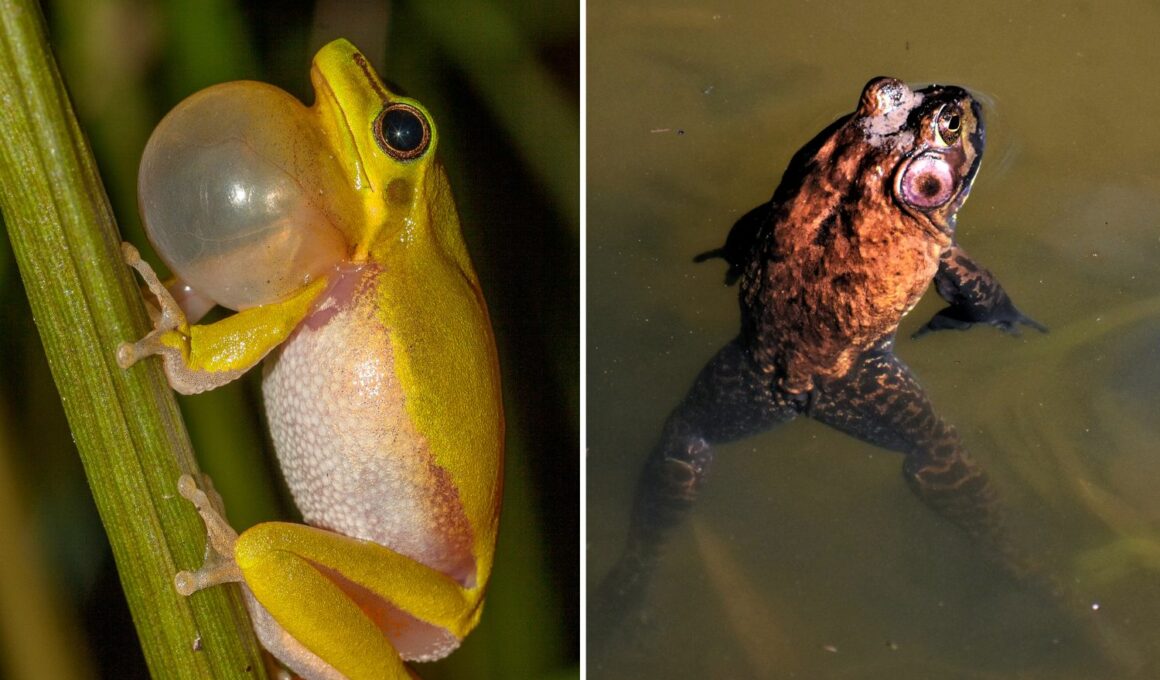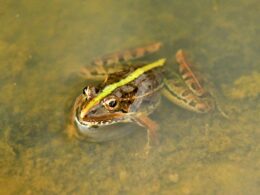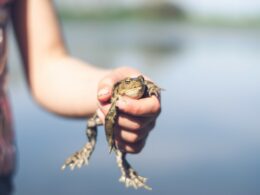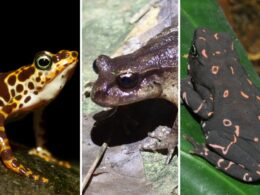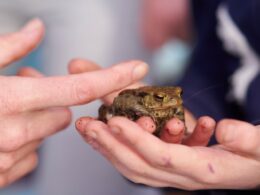In this article Show
Over the years, between caring for my reptilian pets and diving into countless articles and books, I’ve developed a profound admiration for one particular group of creatures: frogs.
These amphibians are not just the usual suspects croaking in your backyard pond; they’re a diverse and astonishing group with abilities and facts that might just leave you in awe.
Let’s jump (pun intended!) right into it and uncover some fantastic facts about our little web-footed friends.
Frogs vs. Toads
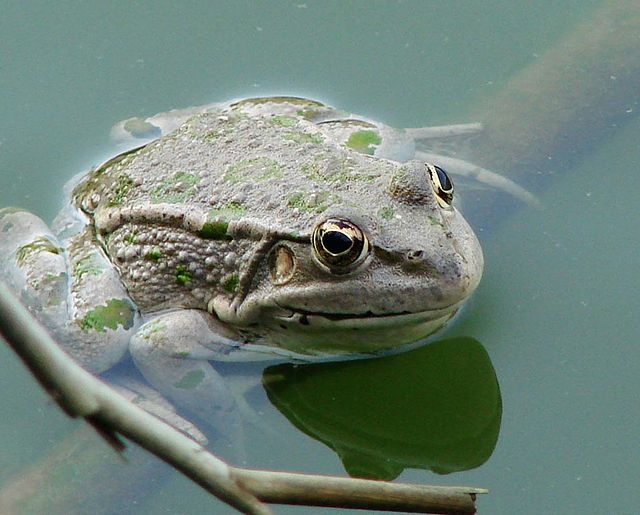
It’s not uncommon for people to use the terms “frog” and “toad” interchangeably, but did you know that there are some clear distinctions between the two? Let’s clear up the confusion:
1. Appearance & Skin
Frogs generally have smooth, moist skin, while toads often have a rougher, drier, and wart-like appearance. This difference in skin texture is not just for show; it’s an adaptation based on their habitats. Frogs usually live in more humid environments, whereas toads are better suited for drier conditions.
2. Legs & Movement
Frogs have long, powerful legs designed for jumping great distances. You’ll often see them leaping around if you approach. Toads, on the other hand, have shorter legs. Instead of hopping like their froggy cousins, they tend to do more of a waddle or short hop.
3. Eggs & Reproduction
When it comes to laying eggs, frogs lay them in clusters, typically floating on water surfaces. Toads, in contrast, lay their eggs in long chains.
Now, let’s address that age-old myth: touching a toad gives you warts. I can’t count the number of times I’ve heard this, and I’m here to set the record straight. This belief is entirely false.
The bumpy protrusions on a toad’s skin are not contagious warts, and they absolutely cannot transfer to humans.
Top Frog Facts
1. Transparent Frogs: The Glass Frog’s See-through Wonder
Now, if you’re into all things unique and fascinating as I am, you’ll find the Glass Frog nothing short of extraordinary. Imagine a creature where you can see its heart beating and watch its inner workings – that’s the Glass Frog for you.
A Glimpse Inside
The Glass Frog, belonging to the family Centrolenidae, possesses a truly mesmerizing feature: transparent abdominal skin. That’s right! One glance at its underside, and you’re treated to a clear view of its internal organs, from its beating heart to the coiling intestines.
Where They Hang Out
These translucent beauties can mostly be found in the rainforests of Central and South America. These regions’ dense, moist canopies offer the perfect environment for them. They’re typically tree-dwellers, spending most of their time up in the leaves.
Why Transparency?
You might wonder, “What’s the advantage of such transparency?” It’s all about camouflage. In the dense rainforests, light filtering through leaves creates a mosaic of light and shadow.
A transparent body blends seamlessly into this environment, making it difficult for predators to spot these frogs. It’s nature’s version of an invisibility cloak!
The Glass Frog’s unique appearance serves as a remarkable testament to the incredible adaptability and diversity of life on our planet.
2. Incredible Jumpers: The Athletic Prowess of Frogs
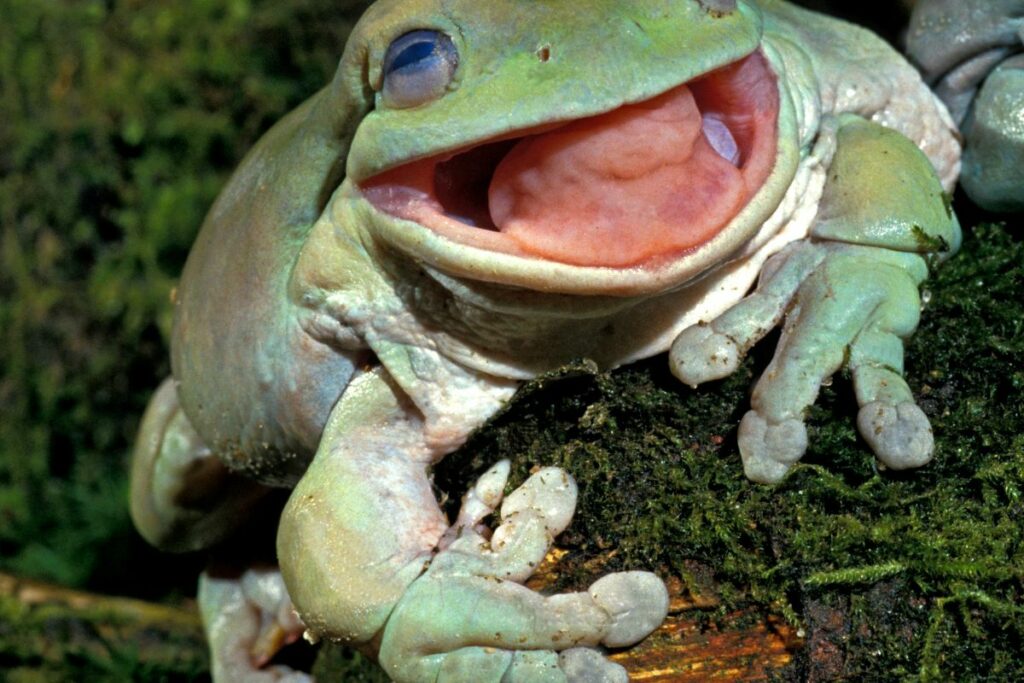
There’s a reason the phrase “to leap like a frog” exists. These creatures are the Olympians of the amphibian world. But have you ever stopped to wonder how they manage those phenomenal jumps?
The Power Behind The Leap
Frogs possess a unique muscular-skeletal structure that sets them up for their athletic feats. Their strong, elongated hind limbs act like springs, storing and releasing energy in a split second.
Coupled with this, their pelvic bones are structured in a way that aids in absorbing the impact of landing. It’s like having built-in shock absorbers!
Moreover, their tendons play a pivotal role. When a frog prepares to jump, its tendons store energy. As the frog leaps, this stored energy is released, propelling the frog forward. Think of it as a slingshot mechanism; the more you pull back, the farther the projectile goes.
Setting Records in the Frog World
While many frogs can jump several times their body length, some truly stand out in their leaping abilities. The award for one of the most impressive jumps goes to the South African Sharp-nosed Frog (Ptychadena oxyrhynchus).
This little champ can leap up to 20 times its body length! That’s like an average human long jumping over an entire basketball court.
Such incredible jumping prowess isn’t just for show. It’s a vital survival tool, enabling frogs to escape predators, hunt for prey, and move quickly through their environments.
3. A Wide Range of Sizes: From Tiny Wonders to Gigantic Jumpers
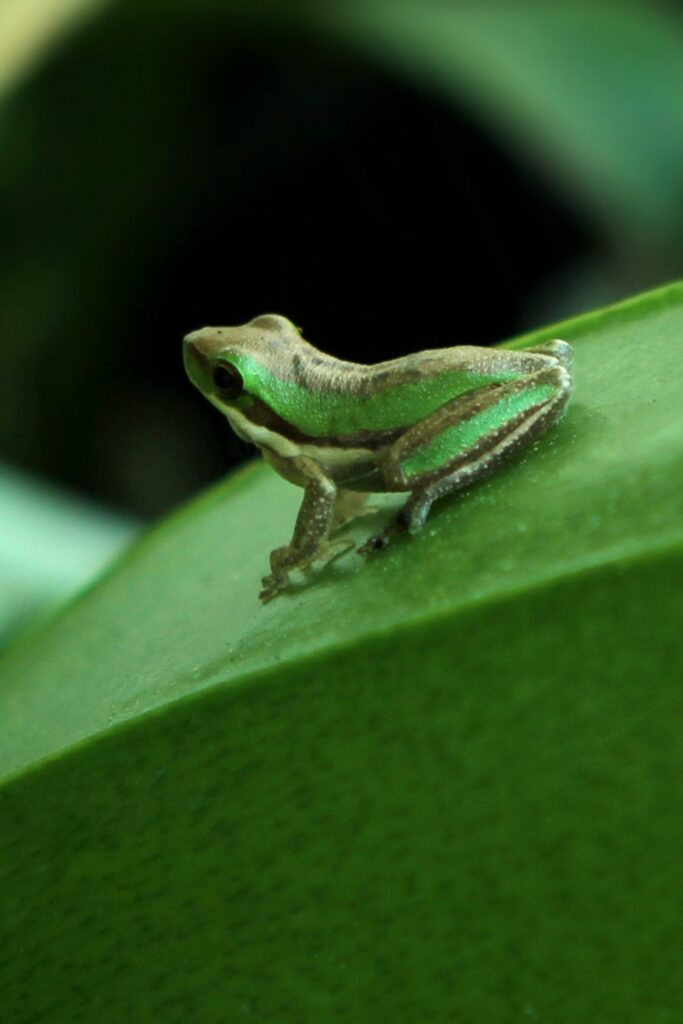
The world of frogs is vast and varied, showcasing an incredible spectrum of sizes. From minuscule marvels to tremendous titans, let’s explore the extremes of frog sizes.
World’s Smallest: The Paedophryne amanuensis
Meet the tiniest champion of the frog world: the Paedophryne amanuensis. Discovered in Papua New Guinea, this frog is so small it could comfortably sit on the tip of your finger! Measuring at a mere 7.7 millimeters in length, it’s comparable to a housefly.
Habitat and Features
This diminutive creature can be found amidst the leaf litter of the tropical rainforests. Their minuscule size grants them an advantage in evading predators. Furthermore, their high-pitched call, resembling the sound of insects, often makes them hard to pinpoint, even if you’re actively listening for them.
World’s Largest: The Goliath Frog
On the other end of the spectrum is the impressive Goliath frog, Conraua Goliath, native to parts of West Africa. With a length reaching up to 32 centimeters (about a foot) and weighing as much as some house cats, this frog is a true behemoth of the amphibian world.
Habitat and Features
The Goliath frog is found near fast-flowing rivers in the rainforests of Cameroon and Equatorial Guinea. One of its most fascinating aspects, aside from its size, is its diet.
While most frogs are content with insects or smaller prey, the Goliath frog feasts on larger fare like bats, birds, and even smaller frogs! Their impressive size also means they have fewer natural predators, allowing them a dominant position in their ecosystem.
From the tiniest to the most gigantic, these frogs demonstrate the astounding diversity and adaptability of nature. Whether they’re evading predators or dominating their habitats, size plays a crucial role in their survival tactics.
4. Unique Parenting Tactics: From Back Carriers to Vocal Sac Nurseries
Parenting in the animal kingdom is full of surprises. And when it comes to frogs, there are a couple of species that truly redefine the norms of childcare. Let’s leap into these incredible stories of amphibian parenting.
The Surinam Toad: A Back-Carrying Mother
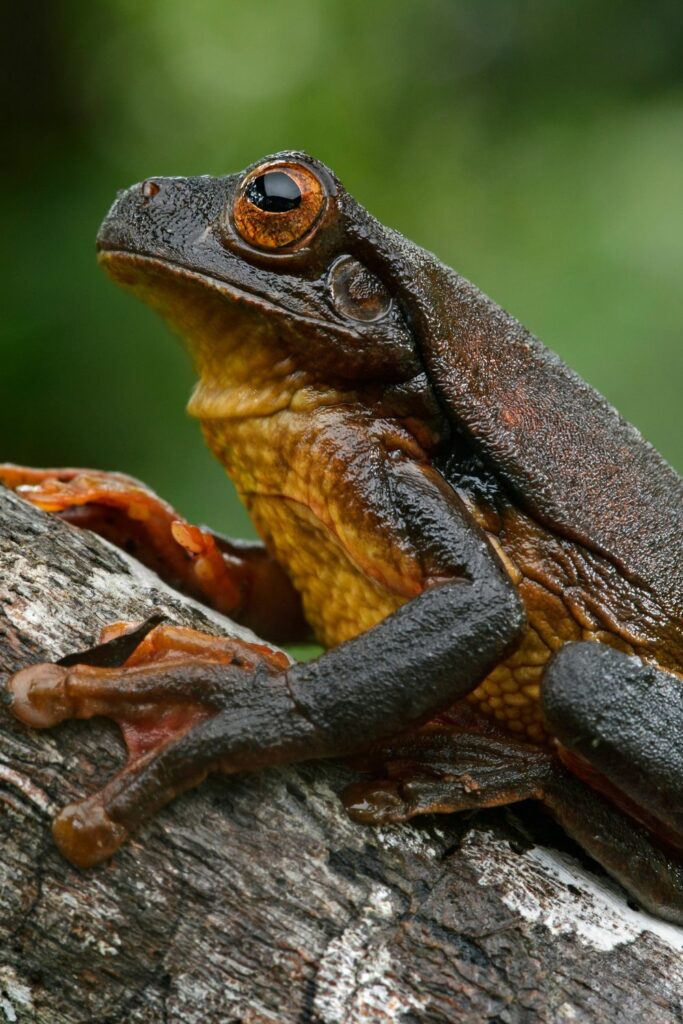
The Surinam toad, or Pipa pipa, is a flat, leaf-shaped amphibian found in the freshwater habitats of South America. But its appearance isn’t the only intriguing thing. When it comes to reproduction, the Surinam toad gives a whole new meaning to “carrying your young.”
After mating, the female toad collects her eggs, and the male places them on her back. Her skin then grows over the eggs, encasing them in pockets. Over time, the eggs develop and mature, literally embedded in her back.
When the time is right, fully formed young toads emerge directly from her skin. It’s an astonishing and slightly eerie sight, but it’s an effective way to protect the developing offspring from potential predators.
Darwin’s Frog: Father’s Vocal Sac Nursery
If you thought the Surinam toad was fascinating, meet Darwin’s frog. Native to the forests of Chile and Argentina, this frog is named after Charles Darwin, who first documented it during his voyages.
In the case of Darwin’s frog, it’s the father who takes on an exceptional parental role. After the female lays her eggs, the male guards them. Once they begin to develop into tadpoles, he swallows them. But don’t be alarmed! He isn’t eating them. Instead, the tadpoles find a temporary home in his vocal sac.
Here, they continue to grow, feeding off their egg yolk. When they are fully developed, the male “coughs” out tiny, fully-formed froglets. It’s nature’s unique twist on fatherly care!
These unique parenting strategies underscore the incredible adaptations amphibians have evolved to ensure the survival of their next generation. They might seem unconventional to us, but in the frog world, it’s all about giving their offspring the best start in life.
5. Amazing Survival Skills: The Wood Frog’s Frosty Feat
Imagine being frozen solid for months and then, come spring, simply thawing out and hopping along as if nothing happened. Sounds like something out of a sci-fi movie, right? Well, for the Wood Frog, it’s just another winter.
The Wood Frog (Rana sylvatica) is native to the cold regions of North America, spanning from the northeastern United States to the Arctic Circle in Canada. When winter arrives and temperatures plunge, the Wood Frog doesn’t migrate or seek deep burrows. Instead, it embraces the cold… quite literally.
Up to 70% of the frog’s body can freeze. Their heart stops beating, their lungs cease to function, and no blood flows. To any onlooker, they would appear dead. But within their cells is where the magic happens.
Nature’s Antifreeze
The Wood Frog’s liver produces large amounts of glucose, a type of sugar, which is then distributed to its cells. This glucose acts as a sort of natural antifreeze, preventing the cells from shrinking and being damaged when the liquid around them turns to ice. The high concentration of glucose ensures the vital organs and cells remain intact during the freezing process.
Springtime Revival
As the warm embrace of spring approaches and temperatures begin to rise, the frozen Wood Frog starts to thaw. The process begins with the innermost organs, like the heart, and gradually spreads to the extremities. Within a few hours, the frog’s heart starts beating again, and it fully revives, ready to embark on its spring and summer activities.
This remarkable adaptation not only allows the Wood Frog to survive in harsh climates but also gives it an advantage. By being one of the first to emerge in spring, it gets a head start on breeding, free from the competition of other amphibians who wake up later.
6. Color-Changing Abilities: Nature’s Dynamic Camouflage Artists
Imagine if you could change the color of your outfit instantly based on your mood or surroundings. While this might sound like a futuristic fashion statement for us, for many frogs, it’s a daily reality.
Chameleons Aren’t the Only Masters
While chameleons often get the spotlight for their color-changing prowess, various frog species also possess this fantastic ability. The reasons for these transformations can range from mood shifts to environmental changes, or even as a response to potential threats.
How Do They Do It?
The secret lies in their skin. Frogs have multiple layers of skin cells called chromatophores, each containing different pigments. Depending on the situation, certain cells can expand or contract, altering the visible color and pattern on the frog’s skin. For instance:
Mood-based Changes
Just like humans can go red with anger or pale with fear, some frogs can change color based on their mood. A calm frog might sport a soft, muted hue, but if agitated or threatened, its colors can intensify.
Environmental Camouflage
If a frog moves from a dark leaf to a light rock, its skin might shift from deep green to a pale gray, blending seamlessly with its new backdrop. This rapid adaptation is crucial for staying hidden from predators.
Temperature Regulation
Color can also influence how much sunlight is absorbed or reflected. In cooler temperatures, some frogs might darken to absorb more heat, whereas in hotter conditions, they might lighten to reflect it.
Survival of the Sneakiest
For frogs, the ability to change color is not merely about aesthetics; it’s a life-saving skill. Whether they’re evading a sharp-eyed bird or sneaking up on a meal, their dynamic skin plays a crucial role in their survival.
Furthermore, sudden color changes can confuse or startle predators, giving the frog an extra moment to escape. In an environment where every second counts, this trick up their sleeve (or rather, skin) can make all the difference.
The next time you spot a frog, take a moment to appreciate its color and remember: there’s a lot more going on beneath the surface than meets the eye.
7. Longest Hibernation: The Mountain Yellow-Legged Frog’s Extended Slumber
When winter blankets the land in snow and temperatures drop, many animals enter a state of hibernation to survive the harsh conditions. Among these winter sleepers, the Mountain Yellow-Legged Frog stands out for its astonishingly long hibernation periods.
The Extended Winter Nap
The Mountain Yellow-Legged Frog, found in the high-elevation regions of California and Nevada, has a unique approach to tackling the cold. As lakes and streams ice over, this frog burrows into the mud at the bottom, where it enters a state of torpor. Here, it can remain for several months – up to 9 months in some cases – effectively hibernating for three-quarters of the year!
How Do They Survive?
While submerged and in torpor, the frog doesn’t breathe through its lungs. Instead, it absorbs oxygen from the water through its skin, ensuring it gets the vital oxygen it needs. During this period, its metabolic rate drops dramatically, reducing the need for food and conserving energy.
Why Such a Long Hibernation?
The environments these frogs inhabit are often inhospitable for most of the year due to snow and freezing temperatures. The extended hibernation allows the Mountain Yellow-Legged Frog to survive these prolonged periods of cold, emerging during the brief summer months to feed, mate, and lay eggs.
Significance of This Adaptation
In the brief window of warmer weather, these frogs need to accomplish everything – from growth and nourishment to reproduction. The ability to hibernate for extended periods ensures they survive to take advantage of this crucial time.
Furthermore, by being largely inactive during the colder months, they reduce the risk of predation and exposure to the elements.
This adaptation also underscores the delicate balance in their ecosystem. Climate changes, which might shorten or lengthen the cold periods, can drastically affect their survival and breeding patterns.
The Mountain Yellow-Legged Frog’s hibernation strategy is yet another testament to nature’s incredible ability to adapt and endure in even the most challenging conditions.
8. Unique Mating Calls: The Serenades of the Frog World
A chorus of croaks, chirps, and trills fills the night air, each note telling a different story. Frogs might not have the vocal prowess of songbirds, but what they lack in melody, they make up for in variety and purpose.
Diverse Calls for Diverse Needs
While we often associate frog calls with mating, these vocalizations serve multiple purposes. From claiming territory to warning off rivals or even signaling distress, each call is uniquely tailored to its intent.
Mating Calls
When it comes to attracting a mate, each frog species has a signature call. For females, these calls provide crucial information about the male’s fitness, size, and even genetic quality. It’s nature’s version of a dating profile!
Species with Distinctive Calls
The Barking Tree Frog (Hyla gratiosa)
As the name suggests, this frog’s call sounds uncannily like a dog’s bark. If you were to hear it without knowing the source, you might be on the lookout for a puppy rather than a frog!
Eleutherodactylus coqui
Native to Puerto Rico, the male of this species has a two-note call that sounds like “co-qui.” Interestingly, only the “co” is intended to repel other males, while the “qui” is to attract females.
The Desert Rain Frog (Breviceps macrops)
This tiny frog, found in the coastal desert of Namibia and South Africa, has a distinctive call that went viral on social media a few years ago. Instead of the typical croak, its call sounds like a squeaky toy!
Importance of Calls in Survival
For frogs, calling isn’t without risks. Loud calls can attract predators, making the frog an easy meal. However, the benefits – securing territory, finding a mate, warding off rivals – outweigh the dangers.
Over time, many frogs have also developed strategies to minimize these risks. For instance, some species call in a chorus, making it challenging for predators to single out an individual.
9. Environmental Indicators: Frogs as Nature’s Health Monitors
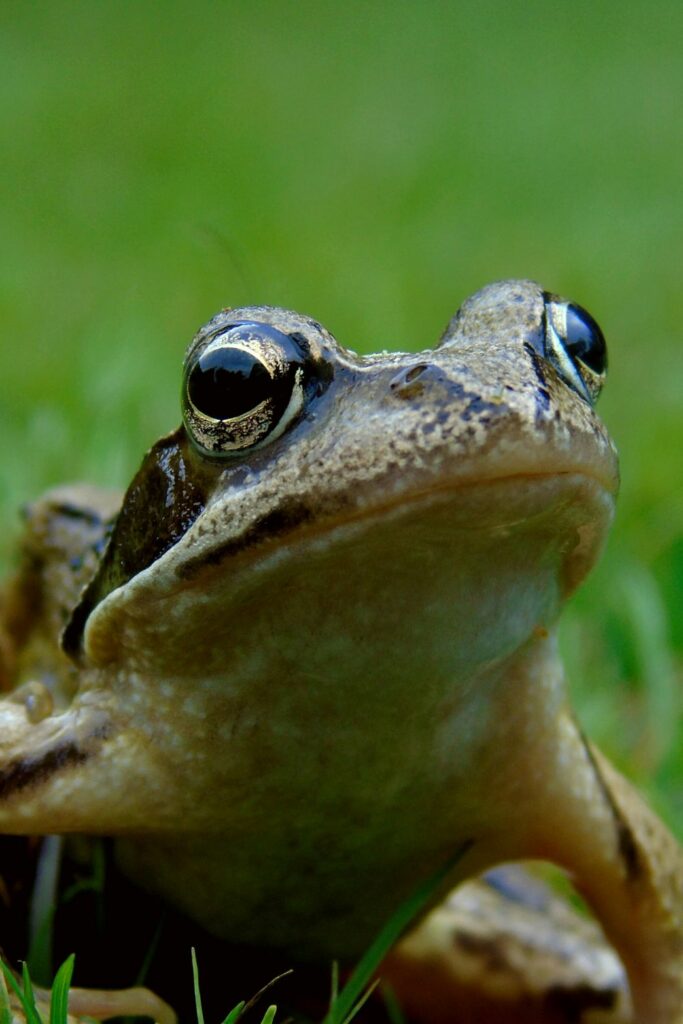
Amidst the colorful palette of nature, frogs hold a unique and vital position, not just for their beauty or the melodies they lend to our evenings, but also as sentinels of environmental health. When the frogs speak – or more accurately, when they go silent – it’s essential that we listen.
Frogs as Bio-indicators
The term “bio-indicator” refers to organisms that help us understand the health of an ecosystem, and frogs fit this role perfectly. But what makes them so special in this regard?
Sensitive Skin
Frogs have permeable skin, which means they can absorb substances from their surroundings. This makes them especially sensitive to pollutants and toxins in the environment. If water quality deteriorates or the air becomes laden with harmful chemicals, frogs are often the first to show signs of distress.
Dual Habitat
Frogs live both in water and on land at different stages of their life, making them susceptible to environmental changes in both realms. This dual exposure gives us insights into the health of aquatic and terrestrial ecosystems.
A Concerning Silence
Over recent decades, researchers and nature enthusiasts worldwide have noticed a disturbing trend: the decline of frog populations. In some places, familiar evening choruses have grown eerily silent.
Several factors contribute to this decline:
Habitat Loss
Urbanization, deforestation, and agriculture have significantly reduced frog habitats. Wetlands, crucial for many frog species, are especially vulnerable.
Pollution
Pesticides, industrial chemicals, and other pollutants can contaminate water sources, proving fatal to frog populations.
Disease
Chytridiomycosis, a fungal disease, has devastated frog populations worldwide. The fungus affects the frog’s skin, impairing their ability to breathe and regulate water, often leading to death.
Climate Change
Changes in temperature and weather patterns can disrupt breeding cycles, affect food availability, and introduce new predators or competitors.
Why does it matter? Frogs play a pivotal role in food chains, acting as both predator and prey. Their decline can affect entire ecosystems, disrupting the balance and leading to unforeseen consequences.
Moreover, the loss of frogs can also impact human populations directly. For instance, without frogs to control them, pest populations, like mosquitoes, can surge, increasing the spread of diseases.
The plight of frogs is a clarion call, urging us to take notice of the health of our planet. As protectors of our environment, it’s our responsibility to heed their silent warning and take steps to safeguard not just their future, but ours as well.
Conclusion
From the frozen ponds where the Wood Frog slumbers to the high canopies where the Glass Frog showcases its transparent beauty, frogs grace our planet with a dazzling array of forms, behaviors, and sounds.
They leap, they sing, they change colors, and they astonish us with survival skills that often sound more like fiction than fact.
Yet, beyond their intrinsic beauty and wonder, frogs serve as keystones in our ecosystems. As predators and prey, as indicators of environmental health, and as connectors between aquatic and terrestrial worlds, their role is both profound and indispensable. Their decline or prosperity echoes the health and balance of the world around us.



